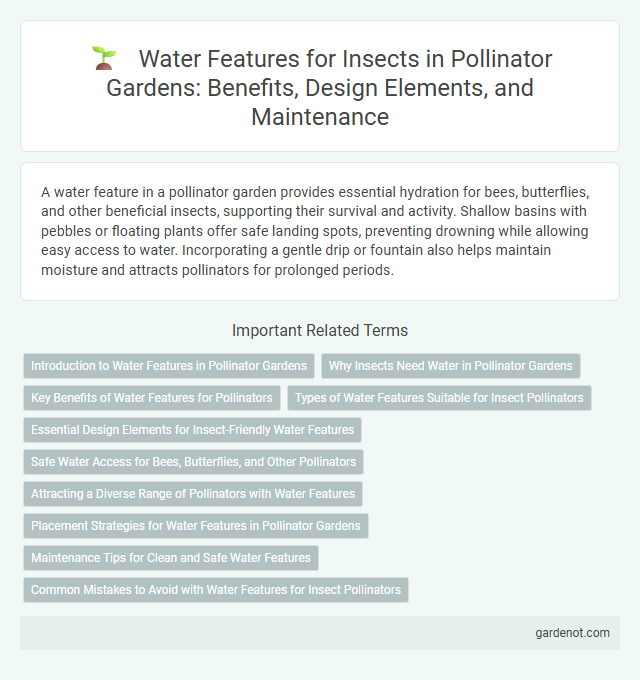A water feature in a pollinator garden provides essential hydration for bees, butterflies, and other beneficial insects, supporting their survival and activity. Shallow basins with pebbles or floating plants offer safe landing spots, preventing drowning while allowing easy access to water. Incorporating a gentle drip or fountain also helps maintain moisture and attracts pollinators for prolonged periods.
Introduction to Water Features in Pollinator Gardens
Water features in pollinator gardens, such as shallow ponds and dripping rocks, provide essential hydration and habitat for bees, butterflies, and other beneficial insects. These features support pollinator health by offering clean water sources and microhabitats that boost biodiversity and encourage pollination activity. Careful design with gentle slopes and exposed stones helps prevent drowning and facilitates easy access for various pollinator species.
Why Insects Need Water in Pollinator Gardens
Water features in pollinator gardens provide essential hydration for insects, supporting their survival and enhancing pollination activity. Moisture sources like shallow ponds or damp areas offer critical drinking and cooling spots necessary for bees, butterflies, and other pollinators. Maintaining accessible water helps sustain insect populations, contributing to a balanced ecosystem and improved garden pollination success.
Key Benefits of Water Features for Pollinators
Water features in pollinator gardens provide essential hydration and breeding habitats for various insects, enhancing their survival and activity. Shallow designs with textured surfaces prevent drowning, making water accessible to bees, butterflies, and other pollinators. Incorporating these elements supports biodiversity and promotes pollination efficiency in garden ecosystems.
Types of Water Features Suitable for Insect Pollinators
Shallow water features such as birdbaths with gently sloping edges, mud puddles, and small containers filled with pebbles provide essential hydration sources for insect pollinators like bees and butterflies. Moving water elements like miniature fountains or drippers create oxygenated environments that attract various beneficial insects while preventing stagnant water, which can deter pollinators. Incorporating native aquatic plants around water features enhances habitat diversity and offers additional nectar and shelter for pollinator species.
Essential Design Elements for Insect-Friendly Water Features
Shallow water basins with textured surfaces provide safe landing spots for pollinators like bees and butterflies. Incorporating gradual slopes and nearby vegetation ensures easy access and shelter, reducing the risk of drowning. Utilizing natural materials such as stones and wood enhances habitat suitability while maintaining water quality for diverse insect species.
Safe Water Access for Bees, Butterflies, and Other Pollinators
Incorporating water features like shallow dishes with pebbles or moss provides essential, safe water access for bees, butterflies, and other pollinators without risking drowning. These water sources help maintain hydration, especially during hot, dry seasons, supporting pollinator health and promoting biodiversity. Regularly refreshed and clean water stations reduce disease spread and attract a diverse range of pollinating species to the garden.
Attracting a Diverse Range of Pollinators with Water Features
Water features such as shallow basins with stones or floating plants provide essential hydration and safe landing spots for various pollinators, including bees, butterflies, and hummingbirds. Incorporating moving water elements like drippers or misters enhances attraction by mimicking natural sources and preventing stagnation. Strategically placing water sources near flowering plants increases visitation frequency, supporting pollinator health and garden biodiversity.
Placement Strategies for Water Features in Pollinator Gardens
Positioning water features in pollinator gardens near flowering plants ensures easy access to hydration for bees, butterflies, and other beneficial insects. Shallow dishes or ponds with gently sloping edges prevent drowning and accommodate small insects. Placing water sources in sheltered, sunny areas helps maintain warmth and reduces evaporation, enhancing their effectiveness for pollinator health.
Maintenance Tips for Clean and Safe Water Features
Regularly clean water features by removing debris and algae to ensure a safe environment for pollinators such as bees and butterflies. Change the water frequently to prevent stagnation, which can attract mosquitoes and harmful bacteria. Adding shallow areas and pebbles helps insects access water easily while reducing the risk of drowning.
Common Mistakes to Avoid with Water Features for Insect Pollinators
Shallow water sources with gradual slopes prevent insect drowning, a common mistake in pollinator gardens. Avoid stagnant water that promotes mosquito breeding and opt for moving or aerated features to maintain healthy environments. Incorporating flat stones or floating platforms offers safe landing zones for bees, butterflies, and other beneficial pollinators.
Water feature for insects Infographic

 gardenot.com
gardenot.com